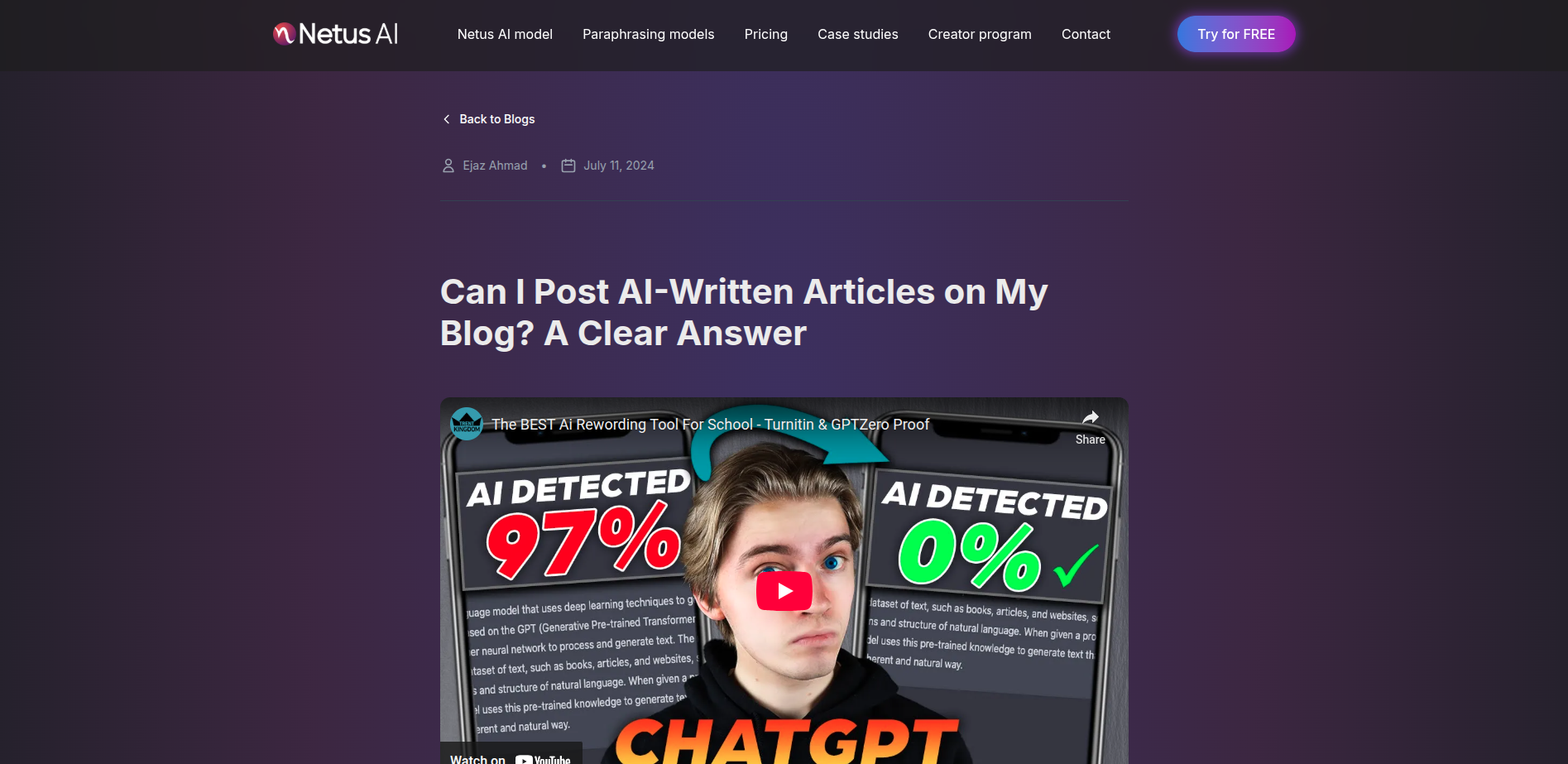Can I Post AI-Written Articles on My Blog? A Clear Answer
Ashley Merit
Content writer and editor for Netus.AI
Table of Contents
Can I Post AI-Written Articles on My Blog? Artificial intelligence (AI) has revolutionized the way we live and work, and its impact on content creation is no exception. With the help of AI, it is now possible to generate articles and blog posts in a matter of seconds. However, many bloggers are left wondering whether it is ethical to post AI-written articles on their blog.
The answer to this question is not a simple yes or no. While AI-generated content can save time and effort, it also raises concerns about authenticity and originality. Additionally, there are legal and ethical implications to consider, such as copyright infringement and misleading readers. In this article, we will explore the pros and cons of using AI for content creation and provide insights on whether it is appropriate to post AI-written articles on your blog.
Understanding AI in Content Creation
The Role of AI Writing Tools
AI writing tools have revolutionized the content creation industry by automating the writing process, enabling content creators to produce high-quality content at scale. These tools use natural language processing (NLP) and machine learning algorithms to generate human-like content that is coherent and engaging.
AI writing tools have several benefits, including saving time and effort, reducing costs, and improving the overall quality of content. They can also help content creators generate ideas, research topics, and optimize content for search engines.
However, it is important to note that AI writing tools are not perfect and may produce content that is inaccurate, irrelevant, or plagiarized. Therefore, it is crucial to review and edit the content generated by AI tools before publishing it on a blog or website.
Evolving SEO and AI Content
Search engine optimization (SEO) is an essential aspect of content creation, and AI writing tools have transformed the way content is optimized for search engines. AI tools can analyze search engine rankings, identify keywords, and suggest changes to improve content visibility.
Google, the most popular search engine, has also incorporated AI into its search algorithms to provide users with relevant and high-quality content. Google’s algorithms analyze content for relevance, accuracy, and engagement, and use this information to rank content in search results.
As AI continues to evolve, it is likely that it will have a significant impact on SEO and content creation. Content creators will need to adapt to these changes and use AI tools to create high-quality content that is optimized for search engines.
Preparing to Use AI for Blogging
Outlining and Keyword Research
Before using AI for blogging, it is important to have a clear outline of the article topic and target audience. This will help the AI writing software to generate relevant and engaging content. Keyword research is also crucial as it helps to identify the most relevant and popular keywords that can be incorporated into the article.
Tools such as Jasper and Grammarly can be used for outlining and keyword research. Jasper is an AI-powered tool that can help with topic research and content planning. Grammarly, on the other hand, can help to identify relevant keywords and check for grammar and spelling errors.
Selecting the Right AI Writing Software
Selecting the right AI writing software is crucial for generating high-quality articles. ChatGPT is one of the popular AI writing software that can generate human-like content. It uses deep learning algorithms to understand the context of the article and generate relevant content.
Other popular AI writing software include Jarvis and GPT-3. Jarvis is a powerful AI writing assistant that can help to generate high-quality content quickly. GPT-3, on the other hand, is a language model that can generate human-like text and is widely used in various applications.
In conclusion, preparing to use AI for blogging involves outlining and keyword research, as well as selecting the right AI writing software. By following these steps, bloggers can generate high-quality content that is engaging and relevant to their target audience.
Creating High-Quality AI-Generated Content
When it comes to generating AI-written articles, it’s important to ensure that the content produced is of high quality, engaging, and consistent. Here are some tips to help create top-notch AI-generated content:
Ensuring Originality and Authenticity
One of the biggest concerns with AI-generated content is the potential for plagiarism or lack of authenticity. To ensure originality, it’s important to use reliable AI tools that are trained on diverse sources of information. Additionally, editing and refining the AI drafts can help to ensure that the content is unique and authentic.
Editing and Refining AI Drafts
While AI-generated content can be a great starting point, it’s important to edit and refine the drafts to ensure that the tone and consistency are maintained throughout the article. This can involve checking for grammar and spelling errors, adjusting the tone to match the target audience, and ensuring that the content flows smoothly.
To make the editing process easier, it can be helpful to use tools such as grammar checkers and style guides. Additionally, having a human editor review the content can help to catch any errors or inconsistencies that may have been missed.
Overall, creating high-quality AI-generated content requires a combination of reliable AI tools and careful editing and refinement. By following these tips, it’s possible to produce engaging and authentic content that resonates with your audience.
Optimizing AI Content for Your Audience
When it comes to optimizing AI content for your audience, there are several key factors to consider. From personalization to incorporating visuals and media, these elements can help make your content more engaging and effective.
Personalization and Brand Voice
One important aspect of optimizing AI content is personalization. By tailoring your content to your target audience, you can make it more relevant and engaging. This can include using language and terminology that resonates with your readers, as well as incorporating examples and anecdotes that are relatable.
Another key factor is brand voice. Your content should reflect the tone and style of your brand, whether that’s serious and professional or playful and lighthearted. This can help establish your brand as a trusted and authoritative source of information.
Incorporating Visuals and Media
In addition to personalization and brand voice, incorporating visuals and media can also help optimize your AI content. Images, videos, and other multimedia elements can help break up text and make your content more visually appealing.
However, it’s important to use these elements strategically. Images should be relevant and high-quality, while videos and other media should be engaging and informative. By using these elements effectively, you can enhance the user experience and make your content more engaging and effective.
Overall, optimizing AI content for your audience requires a strategic and thoughtful approach. By considering factors such as personalization, brand voice, and visuals, you can create content that resonates with your readers and helps achieve your goals.
Complying with Webmaster Guidelines
Navigating Google’s Stance on AI Content
When it comes to AI-generated content, Google’s stance is clear: it must comply with their webmaster guidelines. Google’s guidelines state that all content must be original and provide value to the user. This means that content generated by AI must be unique and not plagiarized from other sources.
Additionally, Google requires that content be written for human readers, not search engines. This means that AI-generated content must be readable and understandable to human readers.
To ensure compliance, it is important to have human intervention in the content creation process. This can include editing and proofreading by human writers to ensure that the content is high-quality and meets Google’s standards.
Avoiding Penalties with Original Contributions
Posting AI-generated content that violates Google’s guidelines can result in penalties, such as a decrease in search engine rankings or even removal from search results altogether. To avoid these penalties, it is important to focus on creating original contributions that provide value to the user.
One way to do this is to use AI as a tool to assist in the content creation process, rather than relying solely on AI-generated content. This can include using AI to generate topic ideas or to assist in research, while still having human writers create the content.
In addition, it is important to focus on SEO optimization to ensure that the content is discoverable by search engines. This can include using relevant keywords, optimizing meta descriptions, and ensuring that the content is structured in a way that is easy for search engines to understand.
Overall, complying with Google’s webmaster guidelines is essential when posting AI-generated content on a blog. By focusing on creating original contributions that provide value to the user and using AI as a tool to assist in the content creation process, bloggers can avoid penalties and maintain high search engine rankings.
Conclusion
Posting AI-written articles on a blog can be a great way to save time and effort while still producing high-quality content. However, it’s important to keep in mind that AI-generated content is not a substitute for human-generated content.
When it comes to content marketing, AI-generated content can be a useful tool for creating a large volume of content quickly. However, it’s important to ensure that the content is still relevant and valuable to the target audience.
In terms of thought leadership, AI-generated content can be a useful way to generate new ideas and perspectives. However, it’s important to remember that thought leadership is about more than just generating content. It’s about providing valuable insights and perspectives that can help shape the conversation in your industry.
Overall, the decision to post AI-written articles on a blog will depend on the specific goals and needs of the blogger. While AI-generated content can be a useful tool, it’s important to use it in a way that complements, rather than replaces, human-generated content.
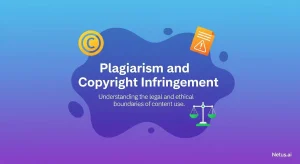
Plagiarism and copyright infringement | NetusAI
Plagiarism and copyright infringement Writers along with academic folks and students really need to steer clear of plagiarism and copyright infringement. They do this to
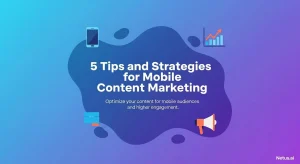
Tips and strategies for mobile content marketing | NetusAI
5 Tips and strategies for mobile content marketing Mobile content really matters a lot these days. Pretty much 98 percent of adults in the U.S.
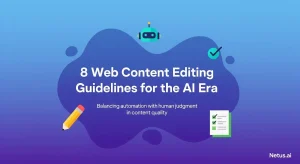
Web content editing guidelines for the AI era | NetusAI
8 Web content editing guidelines for the AI era Editing web content turns out to be pretty tough, especially when generative AI gets involved in
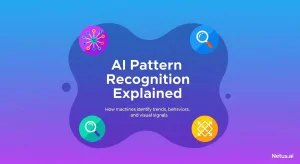
Explaining AI pattern recognition | NetusAI
AI pattern recognition explained Pattern recognition in AI really forms the backbone of what we see in artificial intelligence today. It allows machines to spot
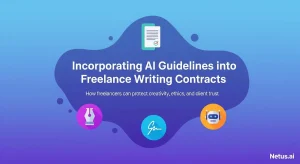
AI Guidelines in Freelance Writing Contracts | NetusAI
Incorporating AI guidelines into freelance writing contracts With AI content prevalent and ranking high on Google, freelance writing contracts must include AI guidelines. This is

Best practices for content SEO | NetusAI
Eight best practices for content SEO Content has to show up and grab attention if it wants to do well. Content SEO takes care of

